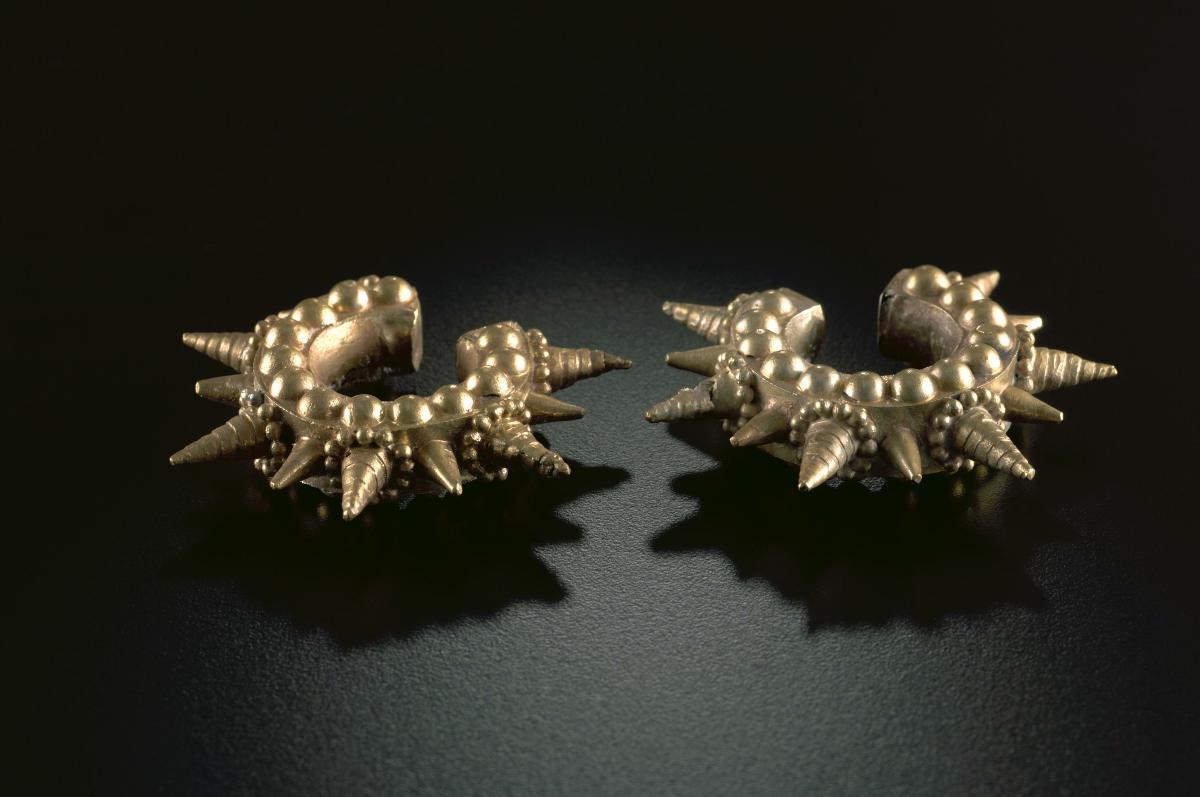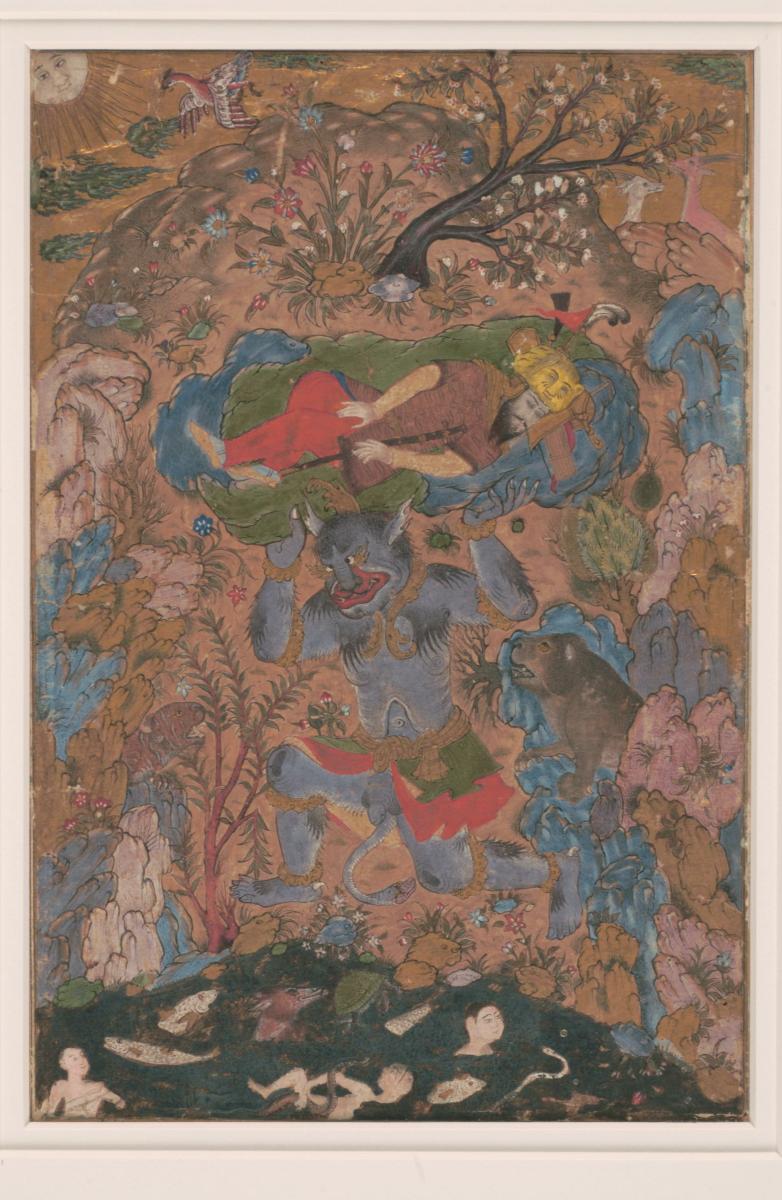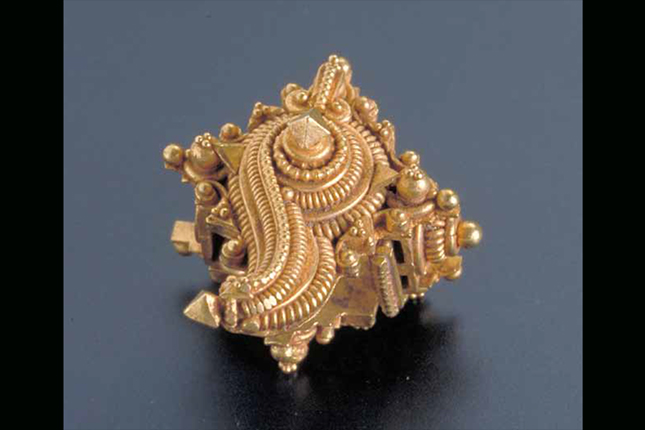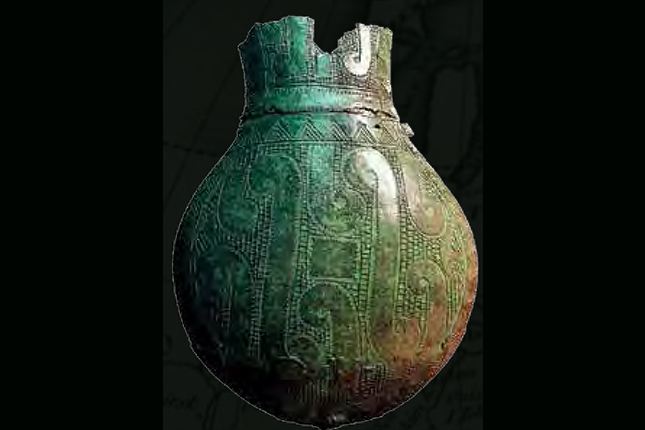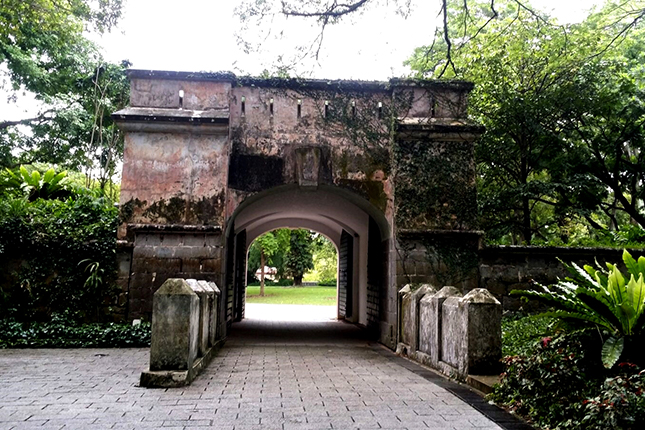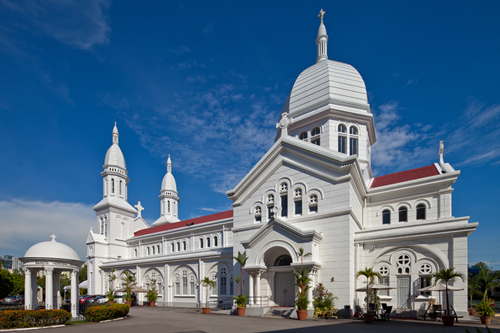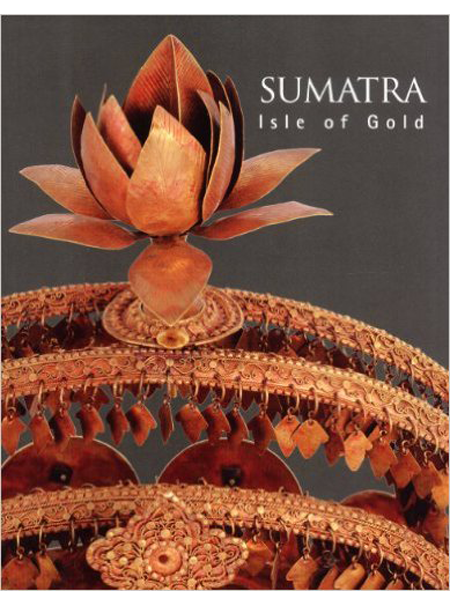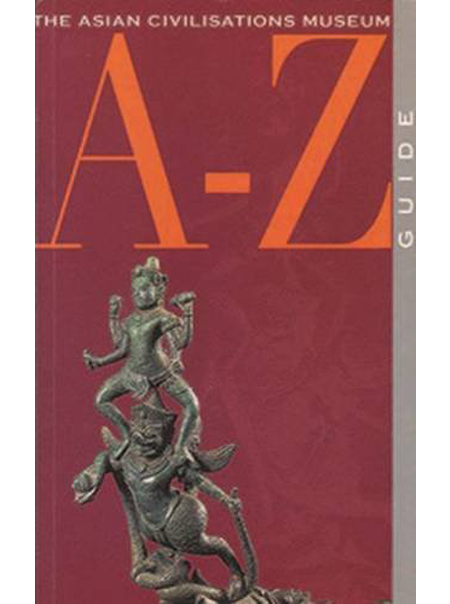Text by Wong Hwei Lian
Be Muse Volume 5 Issue 2 - Apr to Jun 2012
In end-May 2012, visitors to the National Museum of Singapore had the opportunity to view a spectacular collection of 260 pieces of gold jewellery, weapons, coins, household and religious objects. These treasures were on loan from two state museums in Ukraine – the National Museum of the History of Ukraine and the Museum of Historical Treasures of Ukraine. Comprising a wide selection of artefacts from the eighth century BCE to late 19th century CE, this exhibition drew upon the material culture of the northern coast of the Black Sea – an area that corresponds to present-day Ukraine – to present a historical narrative of the region, known to be an important contact point for various cultures over the centuries.
Given the rich and diverse material culture of the Black Sea region, the exhibition chose to focus on object form and its use, so as to explore the interactions between different cultures and contrast their artistic styles and techniques, rather than to adopt the conventional chronological approach. Acknowledging the existence of different nomadic groups and settlements along the Black Sea, the display was divided into two main sections – the Nomads section and the Settled section. The former presented ten nomadic groups through a display of weapons, horse-related ornaments, pole tops, plaques, jewellery and vessels. The latter showcased coins, jewellery and vessels of the Greek colonies established around the Black Sea, as well as illustrated the Byzantine influence over the first empire in the region – the Kievan Rus’ empire.
Among the selection of gold, silver and bronze artefacts, gold featured prominently in this exhibition. Gold not only reflects wealth and status, its durability and malleability further justifies the nomadic aristocracy’s preference for the metal, as did the Greeks in the coastal towns of the Black Sea and the nobility of the Kievan Rus’ empire (late ninth to mid-13th centuries CE). The earliest artefacts in the exhibition were the gold pin inlaid with faience and tiny blue glass beads as well as the twisted gold torque, both dating to the eighth century BCE. These are attributed to the Cimmerians, an equestrian nomadic group who inhabited the area north of the Caucasus and Black Sea till they were displaced by the Scythians around 700 BCE. The pin was uncovered in a burial mound, possibly that of a high-ranking Cimmerian nobleman. Its actual use is uncertain; it could have been used as a clasp or worn as a pendant around the neck.
 Torque (left) and Pin (right), 8th century BCE (Cimmerians). Gold, faience, glass – forging, soldering, inlay. From Cherkasy region, 1984. L7.4 x W10.1cm (Torque), L7.8cm (Pin). © National Museum of the History of Ukraine and Museum of Historical Treasures of Ukraine.
Torque (left) and Pin (right), 8th century BCE (Cimmerians). Gold, faience, glass – forging, soldering, inlay. From Cherkasy region, 1984. L7.4 x W10.1cm (Torque), L7.8cm (Pin). © National Museum of the History of Ukraine and Museum of Historical Treasures of Ukraine.
Of the nomadic groups featured in the Nomads section, the Scythians were well-represented by a diverse selection of artefacts in this exhibition. Believed to be an Iranian-speaking tribe, the Scythians inhabited the steppe regions north of the Black Sea from around seventh century BCE and participated actively in wars and military campaigns. Archaeological findings revealed a rich Scythian material culture, including weapons, horse bridles, pole tops and jewellery, many of which were on display at the exhibition. Several of these artefacts could have been produced in the Greek colonies around the Black Sea. For instance, the gold gorytus cover, which is one of the four found in the region, is believed to be manufactured in the Bosporan workshops in Panticapaeum, a Greek town in Crimea founded between seventh and sixth century BCE by Miletus1. It has been suggested that the scenes either depict the episodes in the life of Achilles or illustrate an Iranian epic. The fine details on the gorytus cover attest to the skilful workmanship of craftsmen residing in Panticapaeum.
 Gorytus cover, 4th century BCE (Scythians). Gold – stamping, embossing. From Zaporizhia region, 1954. H27.5 x W47cm. © National Museum of the History of Ukraine and Museum of Historical Treasures of Ukraine.
Gorytus cover, 4th century BCE (Scythians). Gold – stamping, embossing. From Zaporizhia region, 1954. H27.5 x W47cm. © National Museum of the History of Ukraine and Museum of Historical Treasures of Ukraine.
By sixth century BCE, workshops catering to the tastes and demands of the nomadic aristocracy had also emerged in other Greek towns such as Olbia. With both local Greek and Scythian craftsmen employed in the workshops, it is not surprising that visitors saw a rich blend of influences, particularly from the Greeks, on the objects in the Nomads section. Shared iconography between Scythian and Greek art was also visible on one of the highlights in the exhibition – the gold sword and scabbard stamped with the motif of a stag attacked by a griffin and lion.
 Sword and scabbard with boar head, 4th century BCE (Scythians). Gold, iron – stamping. From Zaporizhia region, 1979. L65.5cm. © National Museum of the History of Ukraine and Museum of Historical Treasures of Ukraine.
Sword and scabbard with boar head, 4th century BCE (Scythians). Gold, iron – stamping. From Zaporizhia region, 1979. L65.5cm. © National Museum of the History of Ukraine and Museum of Historical Treasures of Ukraine.
Gold was also used to decorate horse trappings, as exemplified by the bridle ornaments and saddle ornaments excavated from tombs. Archaeological excavations also revealed that other than the sacrifice of grooms (male servants) with torques and quivers, horses were also sacrificed during the royal burial process, thereby affirming the importance of these mares to their nomadic masters. Horses were after all crucial to nomadic success and superiority in the steppes, as these animals provided the speed, range and mobility required by nomads in their environment. Equestrian nomads such as the Scythians and the Huns excelled at the Parthian shot, a war tactic in which nomads feigned retreat and then turned back to shoot arrows at their enemies while mounted on horses.
 Group of bridle ornaments, 4th century BCE (Scythians). Gold – stamping. From Sumy region, 1897. H37.7 x W8cm (Head ornament), H12.9-13.3 x W4.2-4.7cm (Cheek pieces), D21-24cm (Plaques). © National Museum of the History of Ukraine and Museum of Historical Treasures of Ukraine.
Group of bridle ornaments, 4th century BCE (Scythians). Gold – stamping. From Sumy region, 1897. H37.7 x W8cm (Head ornament), H12.9-13.3 x W4.2-4.7cm (Cheek pieces), D21-24cm (Plaques). © National Museum of the History of Ukraine and Museum of Historical Treasures of Ukraine.
Apart from weapons and horse-related ornaments, the jewellery and plaques in the Nomads section captured the imagination and spirit of the nomads. Notable among the jewellery display was a gold bracelet inlaid with carnelian, attributed to the Sarmatians (also of Iranian origins like the Scythians). The Sarmatians invaded Scythian territories in the early-third century BCE and were responsible for driving the Scythians into the Crimean peninsula. The red-coloured stones in the gold bracelet suggest the Sarmatians’ fondness for ornamentation.
 Bracelet, 1st century CE (Sarmatians). Gold, carnelian, glass – forging, filigree, granulation, inlay, soldering. From Mykolayiv region, 1974. D6.5cm. © National Museum of the History of Ukraine and Museum of Historical Treasures of Ukraine.
Bracelet, 1st century CE (Sarmatians). Gold, carnelian, glass – forging, filigree, granulation, inlay, soldering. From Mykolayiv region, 1974. D6.5cm. © National Museum of the History of Ukraine and Museum of Historical Treasures of Ukraine.
The prevalent animal style seen in nomadic art is evident on the plaques. Made in a variety of sizes and shapes, with inspiration taken from both real and mythical animals, these plaques – cast in the shape of stag, horse and griffin – would have been used on clothing, horse ornaments and weapons.
 Pair of stag-shaped plaques (left) and pair of horse-shaped plaques (centre), 7th–early 6th century BCE (Scythians). Gold – stamping. From Cherkasy region, 1897. H3.3 x W4.1cm and H3.6 x W4.1cm (stag), H2.7 x W4cm each (horse). Pair of griffin-shaped plaques (right), 7th century BCE (Scythians). Gold – stamping. From Kiev region, 1845. H2.8 x W2.8cm each. © National Museum of the History of Ukraine and Museum of Historical Treasures of Ukraine.
Pair of stag-shaped plaques (left) and pair of horse-shaped plaques (centre), 7th–early 6th century BCE (Scythians). Gold – stamping. From Cherkasy region, 1897. H3.3 x W4.1cm and H3.6 x W4.1cm (stag), H2.7 x W4cm each (horse). Pair of griffin-shaped plaques (right), 7th century BCE (Scythians). Gold – stamping. From Kiev region, 1845. H2.8 x W2.8cm each. © National Museum of the History of Ukraine and Museum of Historical Treasures of Ukraine.
Bridging the Nomads section and the Settled section was a small selection of coins produced in Greek colonies like Olbia, Panticapaeum and Chersonesus. These coins, being an instrument of exchange, serve as a reminder of the economic relations2 between the nomads and the settled Greeks. Though Greek presence in the Black Sea area has been attributed to their need for food and natural resources3, or even as a consequence of overpopulation or natural disasters back in mainland Greece, a more plausible explanation for exerting domination over the Black Sea area is the Lydians’ hostile policy towards Miletus and the grim political situation within the city. This resulted in Greek colonies being established in Borysthenes (late seventh century BCE), Olbia (mid- sixth century BCE) and Chersonesus (early fifth century BCE). The colonising activity by Miletus lasted till 530 BCE when the Persians started to conquer these colonies. The Greeks also took control of the rivers, including Dniester, Southern Bug, Dnieper, Don, Kuban and the Kerch Strait, thus the trade routes. In a way, the Greek colonies of the Black Sea region connected the classical Greek world and the steppes on the northern coast of the Black Sea, leading to the creation of a unique syncretic material culture in the Black Sea region. Furthermore, immigrant goldsmiths from mainland Greece brought highly decorative forms to the jewellery through stone inlays and techniques such as granulation and filigree, thus generating variety and excitement for the Black Sea region’s material culture.
 Earring (left), 3rd century CE. Gold, agate - forging, filigree. From Chersonesus region in Crimea, 1981. H3.8cm. Serpent-shaped signet ring (centre), 2nd–3rd century CE. Gold – forging, engraving. From Odessa region, 1958. D2.3cm. Earring (right), 3rd–4th century CE. Gold, carnelian, garnet – forging, filigree. From Chersonesus region in Crimea, 1982. H4cm. © National Museum of the History of Ukraine and Museum of Historical Treasures of Ukraine.
Earring (left), 3rd century CE. Gold, agate - forging, filigree. From Chersonesus region in Crimea, 1981. H3.8cm. Serpent-shaped signet ring (centre), 2nd–3rd century CE. Gold – forging, engraving. From Odessa region, 1958. D2.3cm. Earring (right), 3rd–4th century CE. Gold, carnelian, garnet – forging, filigree. From Chersonesus region in Crimea, 1982. H4cm. © National Museum of the History of Ukraine and Museum of Historical Treasures of Ukraine.
The Black Sea region remained an important contact zone for different cultures over the centuries, during which there were notable external influences on the artistic tradition. These include the Byzantine influence over the Kievan Rus’ state from the ninth century CE onwards. The Kievan Rus’ state founded by Oleg, ruler of the Ryurik dynasty between 879 and 912, was the largest and most powerful state in Eastern Europe during the second half of the ninth century CE4. When the capital of Kievan Rus’ was moved from Novgorod to Kiev in 882 CE, the city Kiev grew to become an important cultural centre. Then in 998 CE, Vladimir the Great who was in power between 980 and 1015 made Eastern Orthodoxy the state religion of Kievan Rus’. This acceptance of Christianity saw the Kievan Rus’ court adopt the manners and fashion of the Byzantine court. The influx of Byzantine priests, artisans and architects to Kiev led to the prevalence of Christian icons, relics and ceremonial objects. This is well-exemplified in the pair of temple pendants with cloissoné enamelled decoration. Worn on the temples (the sides of the faces) of Kievan Rus’ aristorcrats, the pendants are depicted with birds, possibly doves that symbolise the Holy Spirit or a design with its origins from Slav art.
 Pair of temple pendants, 11th–13th century CE (Kievan Rus’). Gold, enamel – stamping, cloisonné. From Kiev, 1876. H5.1 x W4.3cm each. © National Museum of the History of Ukraine and Museum of Historical Treasures of Ukraine.
Pair of temple pendants, 11th–13th century CE (Kievan Rus’). Gold, enamel – stamping, cloisonné. From Kiev, 1876. H5.1 x W4.3cm each. © National Museum of the History of Ukraine and Museum of Historical Treasures of Ukraine.
The use of cloissoné enamelling was also a technique learnt from Byzantine masters in the late 10th century. With the rise of the decorative arts tradition, the craft tradition in the region continued into the 17th century. A small group of decorative objects from the early 17th century to the late 19th century, produced in Kiev as well as Germany and France, are on display at this exhibition. The decorative arts tradition from Kiev is represented here through the works of Ukrainian master craftsmen like Ivan Ravich and Iosef Marshak. During this time, silver was exalted like gold. Though silver alone reflected the wealth and status of the individual, craftsmen also had the option of gilding the silver objects such that both gold and silver-gilt objects were indistinguishable.
 Teapot, c1715. Silver, wood, coral – casting, chasing, gilding, engraving. Master Ivan Ravich, Kiev. H18 X W19cm. © National Museum of the History of Ukraine and Museum of Historical Treasures of Ukraine.
Teapot, c1715. Silver, wood, coral – casting, chasing, gilding, engraving. Master Ivan Ravich, Kiev. H18 X W19cm. © National Museum of the History of Ukraine and Museum of Historical Treasures of Ukraine.
The use of gold and its significance in the Black Sea region was an important focus of this exhibition. The value, aesthetic beauty and universal appeal of gold have not diminished with time. The gold objects in particular reflected a blend of artistic traditions and styles unique to the Black Sea region; testifying to the knowledge and skills of the craftsmen; and encouraging a deeper understanding and appreciation of the cultural contexts and influences through the centuries.
Wong Hwei Lian is Curator, National Museum of Singapore.














